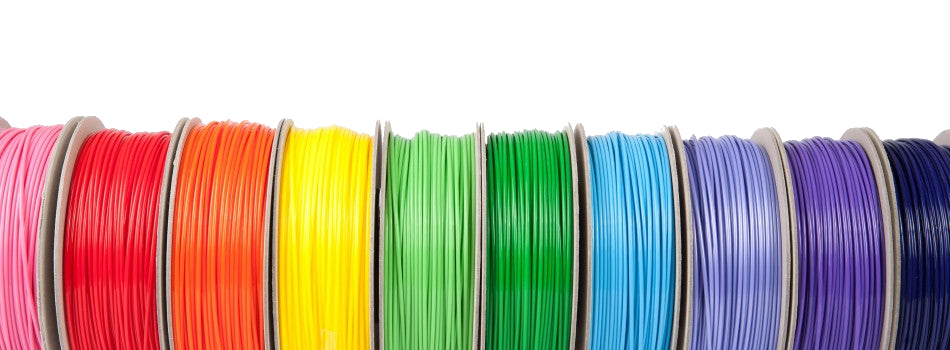For those of us using a 3D printer for the first time, or looking at what is involved with them, one of the most important components when it comes to 3D printing is the Filament that you use.
Many 3D printers can print in either ABS or PLA filament so it often comes down to what you are planning to print and personal choice that dictates which thermoplastic filament you want to buy.
I’m going to go through the two main types of filament and what each one is best used for to help make it easier for you to choose. Along with the best way to store these filaments once you’ve bought them to ensure their longevity and maximum performance from the filaments when being used.
The Best Way To Store Filament
If you are looking at purchasing good quality 3D printing filaments then making sure they are stored correctly is extremely important. The big issue with thermoplastic filament is that like anything, over time it begins to absorb the moisture from the atmosphere around it. And while once the filament has been used to actually print something this is not an issue, making sure as little moisture is absorbed by the unprocessed filament is vital for a great quality final 3D printed product.
By absorbing moisture into the filament it created small water bubbles, when the plastic is heated within the printing head the water boils and pops. This makes the plastic spew out everywhere onto the printing tray as opposed to being carefully released by the printing tip. This can reduce the quality of your 3D prints dramatically and even ruin small complex 3D printing.
The easiest way to combat this is a relatively cheap and quick option, we always recommend that filament, when not in use, is stores in a plastic sealable bin with a small open container of uncooked rice to help draw away any moisture within the immediate atmosphere. This will keep your filament dry and working great!
Now onto which filament is best for you and your needs……
Why Choose ABS?
- Pieces printed in ABS are more flexible and less brittle then PLA, which is a plus if you are printing toy pieces as these get a lot of use.
- Items printed using ABS will generally have a nice glossy finish.
- ABS filament is the better product when creating interlocking pieces or intricate pin connected pieces as it is easier to work with due to its flexibility.
- ABS has a stronger smell compared to PLA when printing so should be used in a well ventilated area.
- ABS prints out at a higher temperature than PLA, around 220 to 260 degrees Celsius depending on the printer used.
- ABS is more heat resistant compared to PLA and wont start to become malleable until around 100 degrees Celsius which makes ABS ideal for items that will sit in the sun a lot, or that will sit in a hot office/car daily.
- ABS, which is short for ‘acrylonitrile butadiene styrene’ is the same type of thermoplastic that LEGO blocks are made from. It is a petroleum based product.
- ABS has a wide range of colours available to purchase.
- Compared to PLA, ABS filament is easier to recycle.
Why Choose PLA?
- PLA, which is short for polylactic acid, is a plastic made from renewable starches such as sugar-beets, corn, potatoes and sugarcane.
- Compared to the petroleum based ABS, PLA Filament is considered the more earth friendly or ‘green’ plastic.
- PLA has a wide range of colours available to purchase.
- PLA is a more ridged filament compared to ABS which makes them ideal for signs or making pieces for home décor.
- In general, parts printed using PLA have more of a glossy, polished finish and are far less prone to warping during the printing process.
- PLA is less heat resistant compared to ABS and will start to become malleable until around 60 degrees Celsius so isn’t recommended for items that will sit in hot rooms/cars for long periods of time.
- It is a biodegradable product and won’t emit a lot of ultra fines particles when printing compared to ABS
- Unlike ABS which emits quite a strong burnt smell when printing, PLA has a more sugary smell when printing which is barely noticeable.
- PLA prints out at a lower temperature than ABS, around 160 to 220 degrees Celsius depending on the printer used.
In Summary…
ABS plastic is usually the preferred plastic for engineers, and professional applications. However, the flexibility, higher temperature resistance and machinability make the ABS filament ideal for those looking to make more intricately designed pin connected or interlocking pieces like puzzles or kit model pieces.
Although the burning plastic type smell along with the fact that it is petroleum based does put some people off towards ABS filament it is easier to recycle compared to PLA.
The amazing range of colours, strong solid final product and glossy look and feel makes PLA filament perfect for those who print items for home décor or small displays.
It is a ‘greener’ option for those who worry about petroleum based plastics and the almost sweet smell when they are being printed. With PLA being far more rigid and creating a sharper finish it is a popular choice for those with home based 3D printers, schools and people who use 3D printing as part of a hobby.

